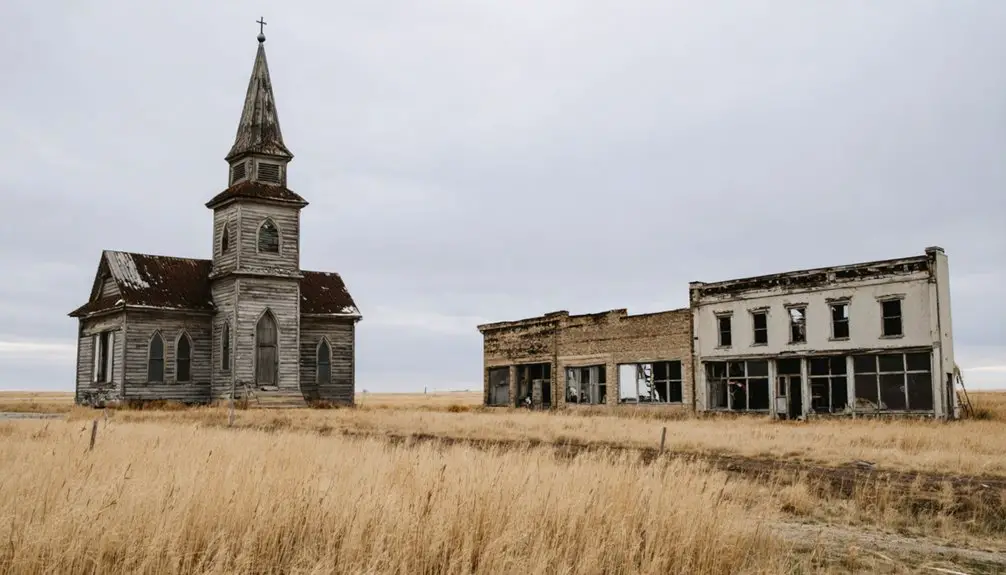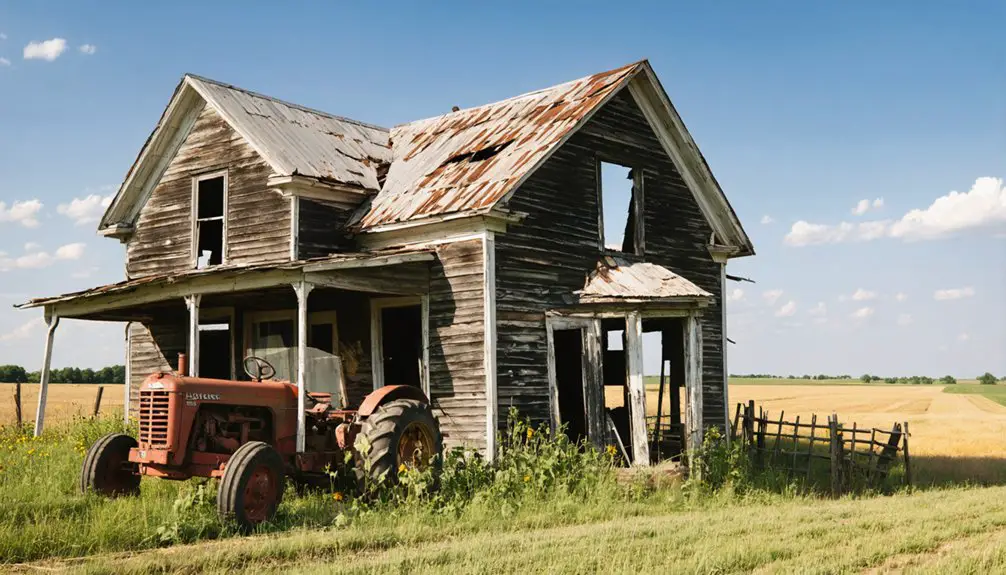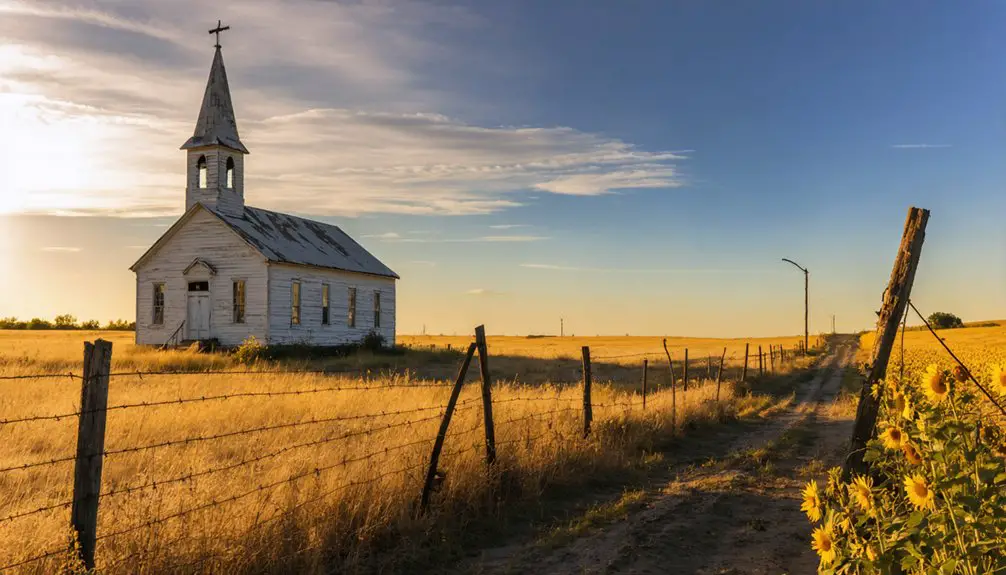You’ll find Beersheba’s remnants near Kansas Routes 156 and 23, where 24 Russian Jewish families established Kansas’s first Jewish agricultural colony in 1882. They built sod houses, a synagogue, and a school while battling harsh prairie conditions. Despite their determination, droughts, blizzards, and economic hardship forced most settlers to abandon their homesteads by 1890. Today, a historical marker and preserved Jewish cemetery reveal this pioneering community’s remarkable story.
Key Takeaways
- Beersheba was established in 1882 by Russian Jewish immigrants near Pawnee Creek but was abandoned by most settlers by 1890.
- Harsh environmental conditions, including droughts, blizzards, and grasshopper invasions, contributed to the settlement’s eventual abandonment.
- The colony’s remains include a preserved Jewish cemetery and a historical marker near Kansas Routes 156 and 23.
- Settlers initially built sod houses and dugouts, but economic hardships forced many to leave farming for railroad work.
- The settlement featured a synagogue, school, and 24 Russian Jewish families before becoming a ghost town due to agricultural failures.
The Birth of a Jewish Agricultural Colony
In response to growing persecution of Jews in Russia during the early 1880s, the Hebrew Union Agricultural Society established Beersheba, Kansas’s first Jewish agricultural colony in 1882. The society, inspired by Rabbi Isaac Mayer Wise’s vision, raised funds through the American Israelite newspaper to support Jewish homesteading efforts.
You’ll find that 59 settlers, mostly families, arrived near Pawnee Creek in Hodgeman County with agricultural aspirations and essential provisions. They received tents, farming tools, livestock, and religious items including a Sefer Torah and shofar.
The society promised each family 160 acres under U.S. homesteading laws if they’d improve and live on the land for five years. With no lumber available, the colonists built sod houses for their homes, storehouse, and school, marking the beginning of their frontier experiment. The settlers focused their agricultural efforts on growing sorghum and vegetables while maintaining their livestock. Unfortunately, the settlement was short-lived as all colonists departed by 1890.
Pioneer Life on the Kansas Prairie
You’ll find that pioneer life in Beersheba centered around the daily struggle to build shelters and grow food in the harsh Kansas prairie environment, where settlers used locally-available materials like sod to construct their homes and barns.
Like other early Kansas settlements established in the 1850s by pioneers, Beersheba’s residents faced the challenges of transforming open prairie into a livable community.
Your survival often depended on adapting quickly to unfamiliar farming techniques while dealing with persistent droughts, limited resources, and isolation from larger communities.
The community established a one-room schoolhouse to educate local children, following the common practice of rural education in Thomas County.
When facing these formidable challenges, the Jewish settlers of Beersheba maintained their faith and cultural practices, though they contended with the same hardships that tested all Kansas pioneers – from makeshift housing and minimal medical care to the constant threat of crop failure.
Daily Struggles and Survival
Life on the Kansas prairie near Beersheba tested settlers’ resilience through a relentless gauntlet of hardships and environmental challenges. Resource scarcity and isolation forced pioneers to adapt quickly or perish. You’d face:
- Devastating droughts that cracked the earth, followed by destructive floods and bitter blizzards that threatened your homestead.
- Weeks or months without seeing another soul, while battling illness without medical care.
- Constant food uncertainty, relying on cornmeal and bacon, supplemented by sporadic wild game.
- Make-do solutions for basic needs, from burning buffalo chips for heat to building sod houses for shelter.
During the severe drought of 1859-60, thirty thousand settlers abandoned their land claims as crops failed and famine spread. The dreaded grasshopper invasion of 1874 brought further devastation, destroying crops and leaving many families destitute. Community resilience emerged through shared hardships, as settlers banded together when possible, though many families had to endure nature’s fury alone.
Your survival depended on unwavering determination and adaptability to the harsh prairie environment.
Building With Prairie Materials
When pioneers first arrived on the treeless Kansas prairie, they quickly learned to adapt their building practices to the available materials at hand.
You’d find early settlers constructing dugouts and sod houses, using thick slabs of topsoil held together by buffalo grass roots. These “soddies” provided natural insulation against harsh weather extremes. By 1938, few sodhouses survived in their original form across the plains.
As homesteaders established themselves, they discovered the value of local limestone, known as “post rock.” Without trees for fuel, settlers relied on bison chips for heating and cooking.
You’ll notice how this durable stone, which hardened after exposure to air, became the preferred building material for permanent structures.
While the railroad eventually brought portable wooden houses in the 1870s, the limited timber along streams wasn’t enough for extensive construction.
The pioneers’ resourceful use of sod construction and limestone durability showcased their ability to adapt and thrive in the challenging prairie environment.
Faith Despite Frontier Hardships
Despite the harsh realities of prairie life, religious faith served as a powerful anchor for Beersheba’s Jewish settlers. Their faith resilience was evident in the establishment of a synagogue, which became the heart of their cultural identity and communal strength.
You’ll find their spiritual determination reflected in these key elements of frontier faith:
- Regular observance of Jewish rituals and gatherings that fostered unity
- Maintenance of traditional life-cycle ceremonies despite isolation
- Selection of the biblical name “Beersheba” to connect with their heritage
- Construction of community institutions like schools and cemeteries
Even as economic hardships forced many to adapt their livelihoods, their shared faith sustained hope. Rabbi Moses Edelhertz served as both the colony’s rabbi and religious butcher, ensuring proper kosher practices were maintained.
When some families had to leave, they maintained their connection to the colony, expressing determination to return and rebuild their prairie community. The colony’s perseverance was demonstrated through sixty Jewish immigrants who initially established the settlement in 1882.
Building a Religious Community
You’ll find the religious heart of Beersheba in its multipurpose building, which served as both synagogue and community center where settlers gathered weekly for Sabbath services.
Under Moses Edelhertz’s guidance as rabbi and ritual slaughterer, the community maintained strict kosher practices and celebrated life’s milestones according to Jewish tradition.
The Hebrew Union Agricultural Society‘s provision of sacred items, including a Sefer Torah and shofar, enabled the settlers to preserve their religious customs despite the challenges of frontier life.
Preserving Jewish Religious Traditions
The Jewish colonists of Beersheba demonstrated unwavering commitment to their religious traditions through carefully structured community practices. Their religious adaptation to frontier life balanced strict observance with practical necessities, ensuring educational continuity for future generations.
You’ll find their dedication reflected in these core practices:
- Weekly Sabbath gatherings combining worship with community consultation
- Kosher slaughter performed by Rabbi Moses Edelhertz according to Jewish law
- Daily Torah study for children and evening sessions for adults
- Multipurpose buildings serving as both synagogue and schoolhouse
Despite the challenges of prairie farming, they maintained their religious identity through structured observance.
They’ve shown how faith-based communities can preserve their traditions while adapting to new environments, creating a sustainable model of religious practice in frontier conditions.
Synagogue Anchors Prairie Faith
Centered prominently among Beersheba’s core buildings, a modest synagogue served as the spiritual heart of this Jewish farming colony.
Whether built of stone or sod, this sacred space housed essential religious items, including a Sefer Torah and shofar, enabling settlers to maintain their faith traditions on the Kansas prairie.
The synagogue’s significance extended beyond religious services, strengthening community identity through weddings, social gatherings, and cultural events.
You’ll find it remarkable that despite harsh frontier conditions, the congregation fostered positive relationships with non-Jewish neighbors, who often participated in community celebrations.
Through support from the Hebrew Union Agricultural Society and Jewish institutions, the synagogue remained a beacon of hope and perseverance, anchoring these pioneering families in their shared faith while building a new life on the American frontier.
Challenges and Early Setbacks

From the moment settlers arrived in Beersheba, they faced severe hardships that would ultimately doom the colony’s survival. The settlement challenges were immediate and overwhelming, with families crowding into primitive sod houses and hillside dugouts roughly 12 x 24 feet in size.
The agricultural difficulties proved especially challenging in western Kansas’s semi-arid climate:
- No local lumber forced reliance on sod construction
- Limited farming knowledge and poor irrigation led to crop failures
- Many men abandoned farming for railroad work
- HUAS’s repossession of farming equipment crushed remaining hope
Internal conflicts between settlers and leadership worsened the situation. While colonists tried improving their homes through whitewashing and decoration, the lack of infrastructure and basic supplies made long-term settlement unsustainable.
The Railroad’s Influence and Economic Shifts
As farming prospects dimmed in Beersheba during 1884, many colonists turned to railroad employment in nearby Cimarron as their economic lifeline.
You’ll find that this shift marked a significant departure from their original agricultural dreams, as younger men especially sought the stable income that railroad work provided.
The economic decline of farming was hastened by several factors: HUAS’s removal of essential tools, harsh winters, and the semi-arid climate.
Some colonists adapted by becoming merchants in Ravanna and Eminence, while others leased their land to cattle trail companies.
However, when Garfield County dissolved in 1892, these alternative ventures collapsed.
You’ll see that by 1890, most colonists had abandoned their homesteads, moving to urban centers like Dodge City and Kansas City for better opportunities.
From Farming Dreams to Urban Reality

The original farming dreams of Beersheba’s settlers gave way to stark urban realities by the mid-1880s.
You’ll find that immigrant experiences shifted dramatically as environmental challenges and economic pressures forced adaptation. When farming proved unsustainable, settlers embraced urban opportunities that offered more stability than the harsh Kansas prairie.
- By 1884, discord over farming equipment ownership led many to seek railroad employment.
- Remaining farmers shifted to leasing land to cattle companies, against HUAS wishes.
- Most colonists had converted to merchant roles in nearby towns by 1890.
- Former settlers established influential presence in urban centers like Wichita.
This urban adaptation pattern wasn’t unique to Beersheba – it reflected a broader trend of immigrant communities evolving from rural to urban livelihoods across late 19th century America.
A Testament to Jewish Settlement in Kansas
While many Jewish agricultural settlements dotted America’s frontier landscape, Beersheba stands out as Kansas’s pioneering Jewish colony established in 1882.
You’ll find evidence of immigrant resilience in how these 24 Russian Jewish families built a community from scratch, complete with a synagogue and school, showcasing their commitment to cultural integration while maintaining their traditions.
Today, you can visit the historical marker near Kansas Routes 156 and 23, commemorating this remarkable settlement experiment.
Though the colony lasted only three years, its impact on Jewish agricultural settlement efforts in America can’t be understated.
The preserved Jewish cemetery, with burials spanning from 1884 to 1933, serves as a poignant reminder of these brave settlers who faced the harsh prairie conditions in pursuit of their American dream.
Frequently Asked Questions
What Natural Disasters Affected the Beersheba Colony During Its Existence?
You’d think flood impacts would’ve been their biggest worry, but drought conditions, bitter blizzards, violent prairie storms, and devastating tornadoes pummeled your fellow settlers, destroying their crops and sod homes.
Did Any Original Buildings or Structures From Beersheba Survive Until Today?
You won’t find any surviving architectural remnants today – historical preservation wasn’t possible since settlers built primarily with sod, and all original structures deteriorated after the colony’s abandonment in the 1890s.
How Did the Colony’s Children Receive Their Non-Religious Education?
With 80 residents in 1883, you’d find children learning in a sod schoolhouse through alternative education methods. The small community’s involvement helped maintain basic schooling despite limited resources.
What Crops Did the Beersheba Settlers Primarily Attempt to Grow?
You’ll find that historical records don’t specify exact crops, though wheat production was likely attempted given Kansas’s agricultural trends. The settlers’ lack of farming experience limited their crop diversity.
Were There Any Notable Conflicts With Native American Tribes in the Area?
You’ll find no direct evidence of Native American conflicts at Beersheba’s location. While Kansas saw intense native relations and conflict history in the 1860s, the colony’s 1882 establishment came after major hostilities.
References
- http://www.kancoll.org/books/harris/sod_chap05.htm
- https://fhsuguides.fhsu.edu/kansasheritage/hodgemancounty
- https://fhsuguides.fhsu.edu/kansasheritage/jewishcolonies
- https://theclio.com/entry/156769
- https://cdp.jewishgen.org/usa/kansas-ks/beersheba-finney-county
- https://www.tabletmag.com/sections/community/articles/jews-on-the-prairie
- https://www.rushcounty.org/RushHistoricalMuseum/
- https://prairiemuseum.org/outdoor-historic-buildings
- https://legendsofkansas.com/pioneer-life-in-kansas/
- https://www.kspatriot.org/index.php/articles/13-kansas-people/447-pioneer-life.html



